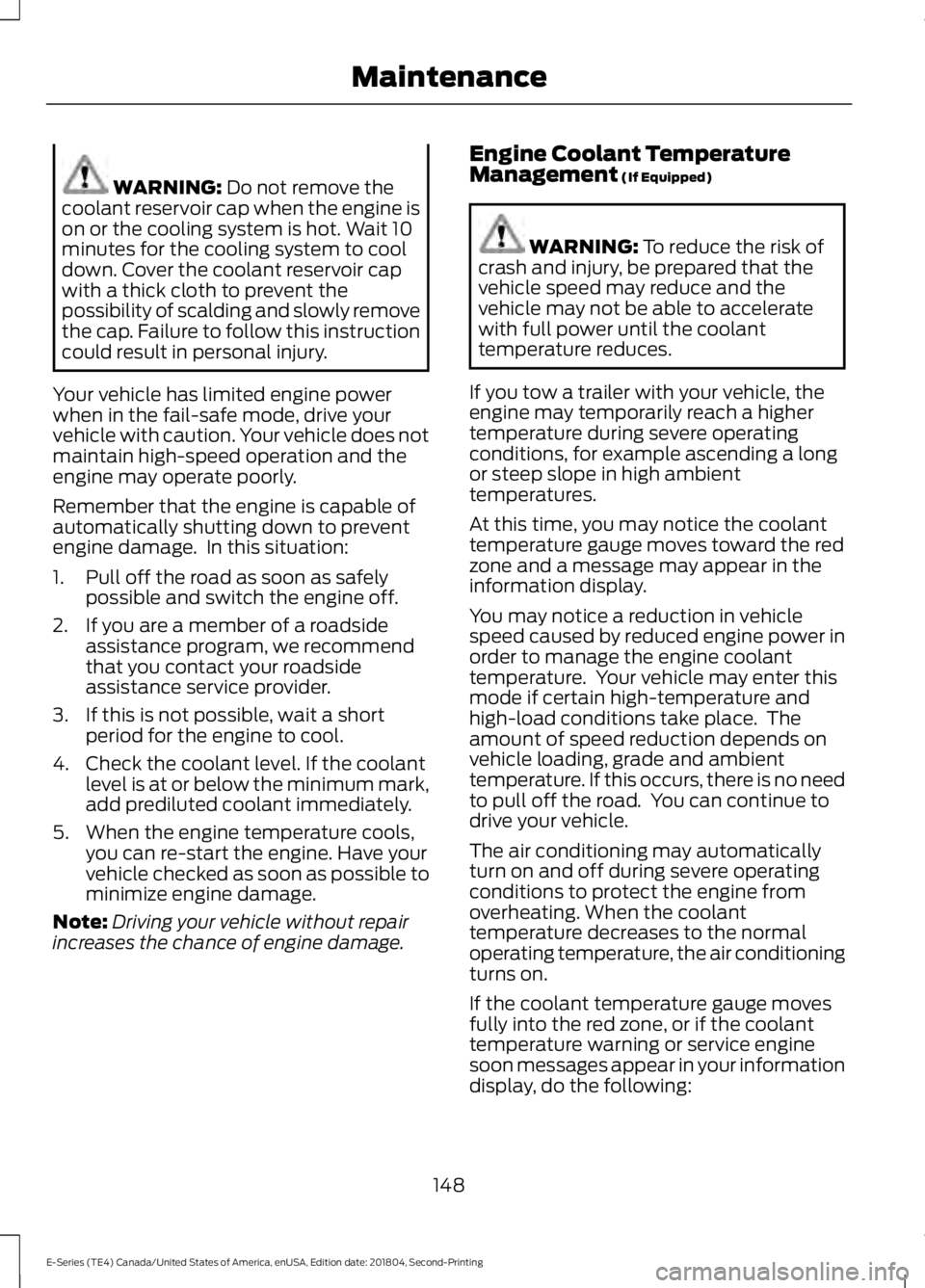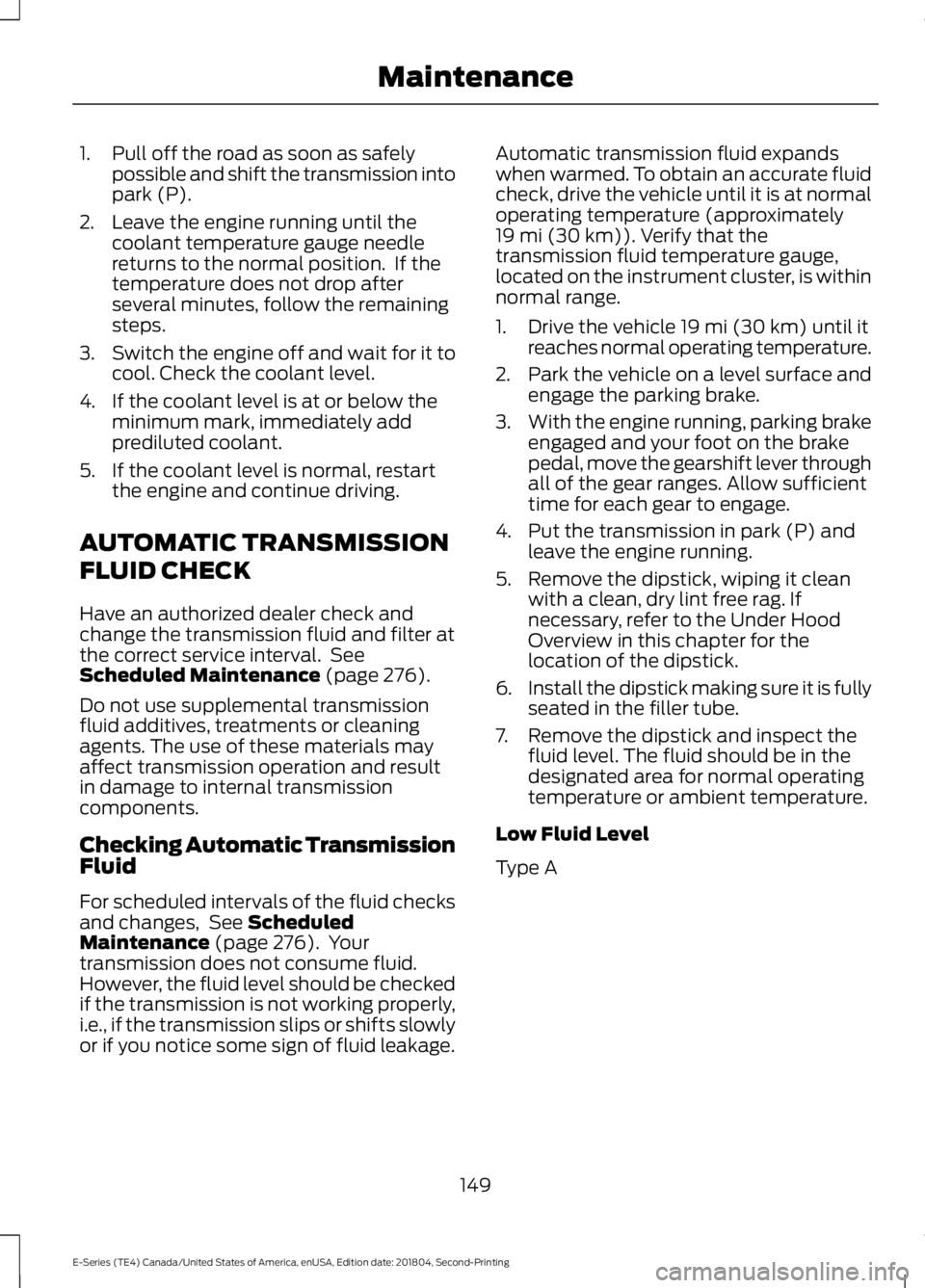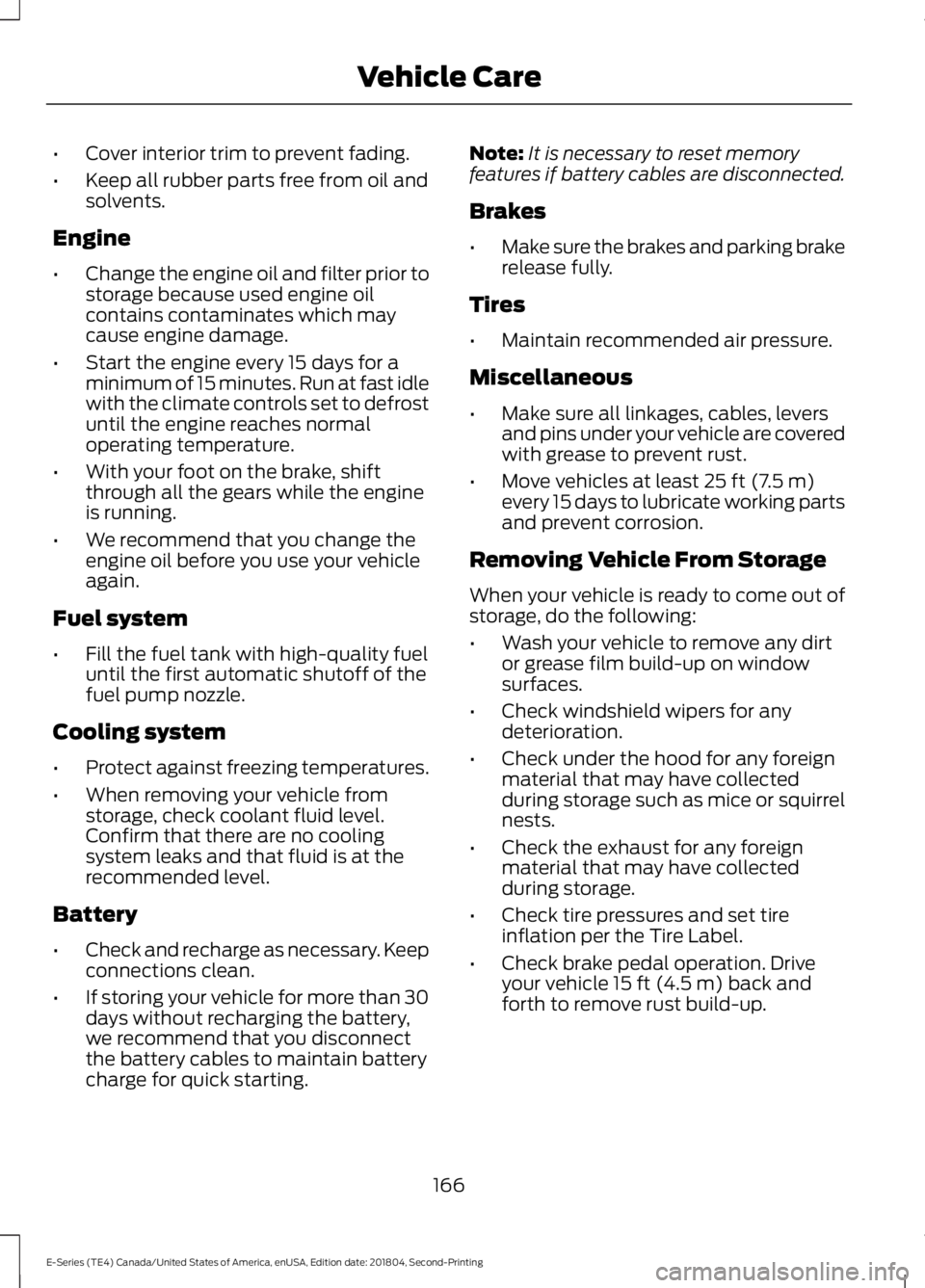2019 FORD E-450 coolant temperature
[x] Cancel search: coolant temperaturePage 151 of 329

WARNING: Do not remove the
coolant reservoir cap when the engine is
on or the cooling system is hot. Wait 10
minutes for the cooling system to cool
down. Cover the coolant reservoir cap
with a thick cloth to prevent the
possibility of scalding and slowly remove
the cap. Failure to follow this instruction
could result in personal injury.
Your vehicle has limited engine power
when in the fail-safe mode, drive your
vehicle with caution. Your vehicle does not
maintain high-speed operation and the
engine may operate poorly.
Remember that the engine is capable of
automatically shutting down to prevent
engine damage. In this situation:
1. Pull off the road as soon as safely possible and switch the engine off.
2. If you are a member of a roadside assistance program, we recommend
that you contact your roadside
assistance service provider.
3. If this is not possible, wait a short period for the engine to cool.
4. Check the coolant level. If the coolant level is at or below the minimum mark,
add prediluted coolant immediately.
5. When the engine temperature cools, you can re-start the engine. Have your
vehicle checked as soon as possible to
minimize engine damage.
Note: Driving your vehicle without repair
increases the chance of engine damage. Engine Coolant Temperature
Management (If Equipped) WARNING:
To reduce the risk of
crash and injury, be prepared that the
vehicle speed may reduce and the
vehicle may not be able to accelerate
with full power until the coolant
temperature reduces.
If you tow a trailer with your vehicle, the
engine may temporarily reach a higher
temperature during severe operating
conditions, for example ascending a long
or steep slope in high ambient
temperatures.
At this time, you may notice the coolant
temperature gauge moves toward the red
zone and a message may appear in the
information display.
You may notice a reduction in vehicle
speed caused by reduced engine power in
order to manage the engine coolant
temperature. Your vehicle may enter this
mode if certain high-temperature and
high-load conditions take place. The
amount of speed reduction depends on
vehicle loading, grade and ambient
temperature. If this occurs, there is no need
to pull off the road. You can continue to
drive your vehicle.
The air conditioning may automatically
turn on and off during severe operating
conditions to protect the engine from
overheating. When the coolant
temperature decreases to the normal
operating temperature, the air conditioning
turns on.
If the coolant temperature gauge moves
fully into the red zone, or if the coolant
temperature warning or service engine
soon messages appear in your information
display, do the following:
148
E-Series (TE4) Canada/United States of America, enUSA, Edition date: 201804, Second-Printing Maintenance
Page 152 of 329

1. Pull off the road as soon as safely
possible and shift the transmission into
park (P).
2. Leave the engine running until the coolant temperature gauge needle
returns to the normal position. If the
temperature does not drop after
several minutes, follow the remaining
steps.
3. Switch the engine off and wait for it to
cool. Check the coolant level.
4. If the coolant level is at or below the minimum mark, immediately add
prediluted coolant.
5. If the coolant level is normal, restart the engine and continue driving.
AUTOMATIC TRANSMISSION
FLUID CHECK
Have an authorized dealer check and
change the transmission fluid and filter at
the correct service interval. See
Scheduled Maintenance (page 276).
Do not use supplemental transmission
fluid additives, treatments or cleaning
agents. The use of these materials may
affect transmission operation and result
in damage to internal transmission
components.
Checking Automatic Transmission
Fluid
For scheduled intervals of the fluid checks
and changes, See
Scheduled
Maintenance (page 276). Your
transmission does not consume fluid.
However, the fluid level should be checked
if the transmission is not working properly,
i.e., if the transmission slips or shifts slowly
or if you notice some sign of fluid leakage. Automatic transmission fluid expands
when warmed. To obtain an accurate fluid
check, drive the vehicle until it is at normal
operating temperature (approximately
19 mi (30 km)
). Verify that the
transmission fluid temperature gauge,
located on the instrument cluster, is within
normal range.
1. Drive the vehicle
19 mi (30 km) until it
reaches normal operating temperature.
2. Park the vehicle on a level surface and
engage the parking brake.
3. With the engine running, parking brake
engaged and your foot on the brake
pedal, move the gearshift lever through
all of the gear ranges. Allow sufficient
time for each gear to engage.
4. Put the transmission in park (P) and leave the engine running.
5. Remove the dipstick, wiping it clean with a clean, dry lint free rag. If
necessary, refer to the Under Hood
Overview in this chapter for the
location of the dipstick.
6. Install the dipstick making sure it is fully
seated in the filler tube.
7. Remove the dipstick and inspect the fluid level. The fluid should be in the
designated area for normal operating
temperature or ambient temperature.
Low Fluid Level
Type A
149
E-Series (TE4) Canada/United States of America, enUSA, Edition date: 201804, Second-Printing Maintenance
Page 169 of 329

•
Cover interior trim to prevent fading.
• Keep all rubber parts free from oil and
solvents.
Engine
• Change the engine oil and filter prior to
storage because used engine oil
contains contaminates which may
cause engine damage.
• Start the engine every 15 days for a
minimum of 15 minutes. Run at fast idle
with the climate controls set to defrost
until the engine reaches normal
operating temperature.
• With your foot on the brake, shift
through all the gears while the engine
is running.
• We recommend that you change the
engine oil before you use your vehicle
again.
Fuel system
• Fill the fuel tank with high-quality fuel
until the first automatic shutoff of the
fuel pump nozzle.
Cooling system
• Protect against freezing temperatures.
• When removing your vehicle from
storage, check coolant fluid level.
Confirm that there are no cooling
system leaks and that fluid is at the
recommended level.
Battery
• Check and recharge as necessary. Keep
connections clean.
• If storing your vehicle for more than 30
days without recharging the battery,
we recommend that you disconnect
the battery cables to maintain battery
charge for quick starting. Note:
It is necessary to reset memory
features if battery cables are disconnected.
Brakes
• Make sure the brakes and parking brake
release fully.
Tires
• Maintain recommended air pressure.
Miscellaneous
• Make sure all linkages, cables, levers
and pins under your vehicle are covered
with grease to prevent rust.
• Move vehicles at least 25 ft (7.5 m)
every 15 days to lubricate working parts
and prevent corrosion.
Removing Vehicle From Storage
When your vehicle is ready to come out of
storage, do the following:
• Wash your vehicle to remove any dirt
or grease film build-up on window
surfaces.
• Check windshield wipers for any
deterioration.
• Check under the hood for any foreign
material that may have collected
during storage such as mice or squirrel
nests.
• Check the exhaust for any foreign
material that may have collected
during storage.
• Check tire pressures and set tire
inflation per the Tire Label.
• Check brake pedal operation. Drive
your vehicle
15 ft (4.5 m) back and
forth to remove rust build-up.
166
E-Series (TE4) Canada/United States of America, enUSA, Edition date: 201804, Second-Printing Vehicle Care
Page 324 of 329

Proper Driver and Front Passenger Seating
Adjustment........................................................ 37
Driving Aids......................................................98
Driving Hints....................................................116
Driving Through Water
.................................117
DRL See: Daytime Running Lamps......................... 50
E
Economical Driving
.......................................116
Electromagnetic Compatibility..............294
Emission Law...................................................83 Noise Emissions Warranty, Prohibited
Tampering Acts and Maintenance...........84
Tampering With a Noise Control System................................................................ 83
End User License Agreement.................296 SYNC End User License Agreement
(EULA).............................................................. 296
Engine Block Heater......................................76 Using the Engine Block Heater........................ 76
Engine Coolant Check................................144 Adding Coolant.................................................... 145
Coolant Change................................................... 147
Engine Coolant Temperature Management................................................... 148
Fail-Safe Cooling................................................. 147
Recycled Coolant............................................... 146
Severe Climates................................................... 147
Engine Emission Control
.............................83
Engine Immobilizer See: Passive Anti-Theft System..................... 45
Engine Oil Check...........................................143 Adding Engine Oil............................................... 143
Engine Oil Dipstick.......................................143
Engine Specifications - 6.2L
....................198
Drivebelt Routing................................................ 198
Engine Specifications - 6.8L....................198 Drivebelt Routing................................................ 199
Environment
......................................................15
Essential Towing Checks..........................108 Before Towing a Trailer...................................... 113
Hitches................................................................... 109
Launching or Retrieving a Boat or Personal Watercraft (PWC).......................................... 114
Safety Chains........................................................ 110
Trailer Brakes......................................................... 110Trailer Lamps.........................................................
113
Trailer Towing Connector................................ 109
When Towing a Trailer....................................... 113
Event Data Recording See: Data Recording............................................... 7
Exterior Mirrors
.................................................51
Fold-Away Exterior Mirrors................................ 51
Power Exterior Mirrors......................................... 51
Telescoping Mirrors ............................................. 52
F
Fastening the Seatbelts..............................28 Seatbelt Locking Modes.................................... 29
Using Seatbelts During Pregnancy................28
Flat Tire See: Changing a Road Wheel........................ 192
Floor Mats
.........................................................117
Ford Credit..........................................................11
US Only...................................................................... 11
Ford Protect
...................................................274
Ford Protect Extended Service Plan
(CANADA ONLY)........................................... 275
Ford Protect Extended Service Plans (U.S. Only)................................................................... 274
Fuel and Refueling..........................................77
Fuel Consumption..........................................81 Advertised Capacity............................................. 81
Fuel Economy......................................................... 81
Fuel Quality - E85...........................................77 Choosing the Right Fuel - Flex Fuel
Vehicles................................................................ 77
Switching Between E85 and Gasoline.........78
Fuel Quality - Gasoline
.................................79
Choosing the Right Fuel..................................... 79
Fuel Shutoff
....................................................120
Fuses..................................................................131
Fuse Specification Chart.............................131
Passenger Compartment Fuse Panel........136
Power Distribution Box...................................... 131
G
Gauges...............................................................53 Battery Voltage Gauge....................................... 54
Engine Coolant Temperature Gauge............54
Fuel Gauge.............................................................. 53
Information Display............................................. 54
321
E-Series (TE4) Canada/United States of America, enUSA, Edition date: 201804, Second-Printing Index
Page 329 of 329

Fuel system..........................................................
166
General................................................................... 165
Miscellaneous...................................................... 166
Removing Vehicle From Storage.................. 166
Tires........................................................................\
. 166
Ventilation See: Climate Control.......................................... 66
VIN See: Vehicle Identification Number.............201
Voice Control....................................................47
W
Warning Lamps and Indicators.................54 Airbag Warning Lamp......................................... 54
Anti-Lock Brake System Warning Lamp.................................................................... 55
Anti-Theft System............................................... 55
Battery...................................................................... 55
Brake System Warning Lamp.......................... 55
Check Fuel Cap..................................................... 55
Cruise Control Indicator..................................... 55
Direction Indicator................................................ 55
Engine Coolant Temperature Warning Lamp.................................................................... 55
Engine Oil................................................................ 55
Fasten Seatbelt Warning Lamp..................... 56
Headlamp High Beam Indicator..................... 56
Low Fuel Level Warning Lamp........................ 56
Low Tire Pressure Warning Lamp.................. 56
Powertrain Malfunction/Electronic Throttle Control................................................................ 56
Service Engine Soon........................................... 56
Tow Haul Indicator............................................... 57
Traction Control System................................... 56
Traction Control System Off............................ 56
Washer Fluid Check.....................................153
Washers See: Cleaning the Exterior............................... 160
See: Wipers and Washers................................. 48
Waxing..............................................................162
Wheel Nuts See: Changing a Road Wheel........................ 192
Wheels and Tires..........................................168 General Information.......................................... 168
Technical Specifications................................. 196
Windows and Mirrors.....................................51
Windshield Washers.....................................48 Windshield Wipers........................................48
Wiper Blades
See: Checking the Wiper Blades................... 155
Wipers and Washers.....................................48
326
E-Series (TE4) Canada/United States of America, enUSA, Edition date: 201804, Second-Printing Index